An Analysis Of 20th
Century Fascism
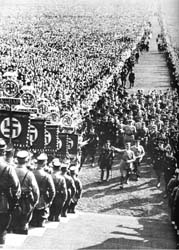  The previous chapter
examined the cultural roots of fascism, how the
ideology was a re-awakening of pagan ideas
reinforced by Darwinism. These facts are most
important for understanding the roots of the
fascism and fascist movements which sprung up in
the 20th century. However, we must also
consider how these movements were able to come to
power in so many countries in the 20th
century, what methods they employed once they had
done so, and the nightmare that resulted. The previous chapter
examined the cultural roots of fascism, how the
ideology was a re-awakening of pagan ideas
reinforced by Darwinism. These facts are most
important for understanding the roots of the
fascism and fascist movements which sprung up in
the 20th century. However, we must also
consider how these movements were able to come to
power in so many countries in the 20th
century, what methods they employed once they had
done so, and the nightmare that resulted.
Right after the end of the First World War, the
first fascist regime of the 20th
century was established in Italy by Benito
Mussolini. Hitler's Germany and Franco's Spain
followed. In the 1930s, fascism became a popular
political ideology, fascist parties both great and
small were set up in many countries, and fascists
came to power in Austria and Poland, thus the
whole of Europe was affected by it.
There are numerous similarities between fascism
in Europe, where the clearest examples of fascism
were seen, and Latin America and Japan, where the
movement also took root and flourished. Generally
speaking, fascism made use of chaos and
instability within a country to impose itself on
its inhabitants, by presenting itself as an
ideology of salvation. Once fascist governments
were established, the people were kept under
control by a mixture of fear, oppression, and
brainwashing techniques.
SOCIAL CRISES: FERTILE GROUND FOR
FASCISM
There were great similarities in the social and
psychological backgrounds of those countries where
fascist states came to be established. Most of the
countries concerned had been defeated and heavily
damaged in the First World War, and thus its
people were worn-out and weary, having lost their
husbands, wives, children, and loved ones in the
war. As well, these countries suffered from a
shattered economy, political instability, and a
general feeling that the nation was in a state of
collapse. People were suffering materially; the
various political parties were incapable of
rectifying the nations' problems, in addition to
fighting amongst themselves.
 After World
War I, much of the population were either
widowed or orphaned. People were dealing with
the sorrow of having lost loved ones and people
close to them, and were also suffering the
psychological and economic problems brought on
by high unemployment. As a result, there emerged
a longing for the old days of glory. After World
War I, much of the population were either
widowed or orphaned. People were dealing with
the sorrow of having lost loved ones and people
close to them, and were also suffering the
psychological and economic problems brought on
by high unemployment. As a result, there emerged
a longing for the old days of glory.
|
Essentially, the poverty Italy was faced with
as a result of the First World War was the most
important factor in the rise to power of Italian
fascism. More than 600,000 Italians had died as a
result of the war, and up to half a million people
were crippled. The greater part of the population
was made up of widows and orphans. The country was
beleaguered by an economic recession and high
unemployment. Although the Italians had suffered
great losses in the war, they had achieved very
few of their aims. Like many other nations
exhausted by the war, the Italian people longed to
recapture their honor and former glory.
Actually, this was a feeling that had been
gathering increasing strength since the end of the
19th century. Modern Italy looked back
with nostalgia at the greatness of the Roman
Empire, and felt it had a right to former Roman
territory. Furthermore, there was a feeling of
rivalry with the major powers of the world, and
Italy hoped to raise itself to their rank, or, to
rise to "the position it deserved." Affected by
these aspirations, the Italians hoped to become as
powerful as Great Britain, France and Germany.
 THE SADDENING RESULTS OF WORLD WAR
I The "Great War" of 1914-1918
ruined Europe. 10 million people died, and many
more millions suffered the emotional and
economic crises that resulted from it. Germany,
in particular, was eager for a way out. Fascism
made use of the
situation. |
Social, political and economic crises also
played the major role in the establishment of
Nazism in Germany, which had been defeated in the
First World War. Unemployment and a financial
crisis added to the disappointment of defeat.
Inflation rose to levels that had seldom been
equaled. Small children played with banknotes
worth millions of marks, because money, which lost
value by the hour, had come to be worth no more
than pieces of paper. The Germans wanted to
restore their lost honor and return to a better
standard of living. It was with the promise of
fulfilling such wishes that Nazism would emerge
and win support.
Pre-fascist Spain also demonstrated close
similarities to these counties. The loss of its
colonies on both sides of the American continent
at the beginning of the 19th century
had led to a serious diminishment of self-esteem.
By the beginning of the 20th century,
Spain was in a state of semi-collapse. Its economy
was failing, and the privileges accorded to the
aristocracy opened the way to great injustices.
The Spanish looked back to the days of a great and
powerful Spain with great longing.
Another country where fascism came to have
enormous influence was Japan. In pre-fascist
Japan, the higher strata of society were very
concerned about the spread of Marxist ideas among
the young. But they were unable to determine how
to rid themselves from that pernicious ideology.
In addition, such social changes were very
disconcerting for a society so tightly bound to
its traditions. Family bonds loosened, the divorce
rate rose, respect for the elderly diminished,
customs and traditions were abandoned, an
individualist tendency began to emerge, degeneracy
among the young reached grievous proportions and
there was an alarming increase in the suicide
rate. In these conditions, the future stability of
the Japanese society was regarded as in jeopardy.
All of the above led to a backward-gazing
nostalgia. Longing for the glory days of the past,
and attempts to revive them, was the first trap
the people fell into leading to their becoming
fully ensnared by a fascist regime.
Neither must we ignore the menace of communism,
which at that time was threatening to overtake the
whole world. It may be that a number of nations
submitted themselves to fascist regimes in order
not to fall victim to that brutal, ruthless and
oppressive ideology, escaping one evil only to be
trapped by another, believing fascism to be the
"lesser of two evils."

THE
VICIOUS CIRCLE OF THE DARWINIAN
IDEOLOGIES:COMMUNISM VS. FASCISM
People
gathered in front of the German Communist Party
building in an anti-communist protest in 1933,
with SA units in the foreground. The slogan on
the building reads, "Forward with the struggle
against the threat of war, fascism, hunger and
cold, in the name of work, bread and freedom."
When the fascist movement began to gain
momentum, communism had already been an emerging
threat. In hopes of avoiding the brutality and
oppressiveness of communism, many countries
turned to fascism as the answer, jumping out of
the frying pan and into the
fire. |
THE UNEDUCATED: FASCISM'S HAPLESS
PREY
 Another factor that opened
the way to fascism was the ignorance and lack of
education of many communities. Education had
suffered heavily during the chaos of the First
World War. A great number of young educated people
had lost their lives on the battlefield. In
general, this led to a lowering of the level of
culture in society. It was largely the ignorant
who supported fascism, fought in its name, and
became pawns of its chauvinistic policies. Because
the fundamental ideas on which fascism were based
(in other words, racism, romantic nationalism,
chauvinism and fantasy) could only be widely
accepted by the uneducated, susceptible as they
were to crude, facile slogans. Another factor that opened
the way to fascism was the ignorance and lack of
education of many communities. Education had
suffered heavily during the chaos of the First
World War. A great number of young educated people
had lost their lives on the battlefield. In
general, this led to a lowering of the level of
culture in society. It was largely the ignorant
who supported fascism, fought in its name, and
became pawns of its chauvinistic policies. Because
the fundamental ideas on which fascism were based
(in other words, racism, romantic nationalism,
chauvinism and fantasy) could only be widely
accepted by the uneducated, susceptible as they
were to crude, facile slogans.
Such people, seeing themselves as trapped,
looked for easy way out. They embraced fascist
leaders, as if they were a kind of lifebelt, as
Eric Hoffer says in his book The True Believer:
For men to plunge headlong into an undertaking
of vast change, they must be intensely
discontented yet not destitute, and they must have
the feeling that by the possession of some potent
doctrine, infallible leader or some new technique
they have access to a source of irresistible
power. They must also have an extravagant
conception of the prospects and potentialities of
the future. Finally, they must be wholly ignorant
of the difficulties involved in their vast
undertaking.34
An examination of the societal conditions that
preceded fascism makes light of the fact that many
people had just such a psychology.
THE METHODS BY WHICH FASCISM CAME
TO POWER
 Mussolini's quasi-paramilitary
Black Shirts. |
Fascism had its first successes in Italy.
Mussolini took advantage of the social tensions
and longing for change among the Italians, and
after the war, mobilized former soldiers, the
unemployed and university students, with slogans
calling for a return of the glory days of ancient
Rome. Mussolini organized his supporters, known as
"Black Shirts," in a quasi-military format, and
whose methods were founded on violence. They began
to carry out attacks in the streets against groups
they identified as their rivals. With their Roman
greetings, songs, uniforms and official parades,
they aroused the emotions of the uneducated and
the disenfranchised.
On October 29, 1922, 50,000 fascist militants
under the command of six generals marched on Rome.
Because the king knew what the force that opposed
him was capable of, and that there was no way he
could oppose them, he called on Mussolini to form
a government. As a result of the developments that
followed, the Italian fascists finally came to
power. A while later, Mussolini banned all other
political parties. Some of the opposition leaders
were sent into exile abroad, and others were
imprisoned.
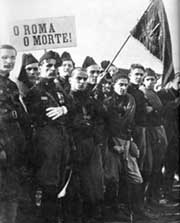
THE COUP
PERPETRATED BY MUSSOLINI'S BLACK
SHIRTS
Opposite. On
October 29, 1922, 50,000 fascist militia, led by
Mussolini, and under the command of six
generals, marched on Rome. The placards they
carried read "Rome or Death."
The picture
on the left shows the fascist militia entering
the gates of Rome at the end of the march. The
march, with so many men, shouting slogans
calling for the return of the glory-days of
ancient Rome, had a profound emotional effect on
an ignorant and despairing public, leading to
ultimately in perceiving fascism as a means to
salvation.
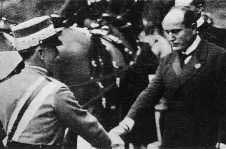 
The King of Italy, was
unable to resist the fascist gang who had
occupied Rome, and called on Mussolini to
establish a
government.
Italia Balbo, the general of the
Black Shirts. |
 The Nazi movement, which began in
the 1920s, carried out its first act of violence
in the Munich Beer Hall putsch. The picture
below shows a good number of the accused in the
trial following the Beer Hall
putsch. |
Hitler came to power by similar methods. The
Nazi movement was born in the early 1920s, and
carried out its first violent act in the Munich
Beer Hall putsch. On November 8, 1923, Hitler
raided a meeting at the Munich City Beer hall
where Bavarian State Commissioner Gustav von Kahr
was speaking with military units, no different
from an organized gang, and 600 SA troopers.
Hitler entered the meeting in a great rage and
occupied the premises. Firing at the ceiling, he
said that he was announcing a national revolution.
But this coup was a failure. Hitler was arrested
and lived as an exile for nine months.
Nonetheless, in later years, the Nazis grew
stronger by terrorizing their opponents and
inciting anti-Semitic hatreds. Eventually, the
Nazi Party became an important party in
parliament. Throughout all this, of course, the
Nazis frequently resorted to illegal methods, much
like the Italian Fascist party. On January 30,
1933, Hitler was made chancellor. The post was
conferred upon him by the elderly President
Hindenburg, who was aware that the growing power
of the national Socialist Movement was
increasingly menacing, and therefore, made Hitler
chancellor in order to avert a civil war.
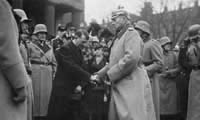 On January 30, 1933, Hitler was
made Chancellor by President Paul von
Hindenburg. |
When Hitler again ran for election in March,
like all fascist administrations, the Nazis
employed terror, intimidation, and deception.
After the elections, the German parliament
immediately passed the Enabling Act, which made
Hitler dictator of Germany for four years.
In this manner, the administrative and
law-making power came into Hitler's hands. But,
shortly thereafter, the extent of his powers were
increased still further. In August 1934, at the
death of Hindenburg, the offices of president and
chancellor were joined together, with Hitler
assuming them both. Hitler followed policies much
like those of Mussolini. In addition to brute
force, Hitler also made use of various types of
anti-democratic methods. For instance, he banned
all opposition parties, and outlawed trade unions,
thereby completely eliminating personal freedoms.
Nazi influence was felt in all walks of life. Even
university professors were required to take an
oath of loyalty to Hitler.
In Spain, Franco came to power in the aftermath
of a bloody civil war. Supported by Hitler and
Mussolini, Franco's army defeated the communists
after a long and fierce war, and took power over
the entire country. Franco then set up a
particularly oppressive regime, and ruled the
country with an "iron fist" until 1975.
BRAINWASHING TECHNIQUES OF
FASCISM
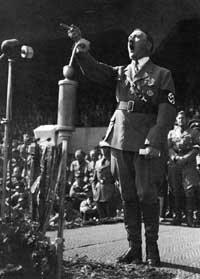 Crowded Nazi rallies were held
with rousing anthems and pomp, and were
specifically intended to awaken a feeling of awe
and fear, thus enthralling the ignorant public.
Effectively, fascism was an ideology based on
emotion, not reason.
|
There was one particularly egregious feature of
Italian fascism and Nazi Germany: its attempt to
brainwash its citizens. This program was founded
on two basic components, education and propaganda.
In Mein Kampf, Hitler wrote, "Propaganda is a
means and must therefore be judged with regard to
its end... Propaganda in the War was a means to an
end, and the end was the struggle for the
existence of the German people; consequently,
propaganda could only be considered in accordance
with the principles that were valid for this
struggle. In this case the most cruel weapons were
humane if they brought about a quicker victory...
All propaganda must be popular and its
intellectual level must be adjusted to the most
limited intelligence among those it is addressed
to. Consequently, the greater the mass it is
intended to reach, the lower is purely
intellectual level will have to be."35
Hitler was certainly effective in his use of
propaganda. For instance, the well-known director
Leni Riefenstahl was requested to produce a Nazi
propaganda film, Olympia. In Triumph of Will,
another film by Riefenstahl, Hitler was shown as
an almost divine being. Pagan Nazi ideology was
praised in all these films, and ultimately imposed
upon society. Olympia was one of the old centers
of ancient Greek pagan culture. The city, with its
famous statue of the Greek god Zeus, was a fitting
symbol of the pagan ideology of Nazism.
All fascist regimes, not just Hitler's, used
propaganda in a most effective way in order to
impose their will on the public. Mussolini openly
stated this:
For me the masses are nothing but a herd of
sheep as long as they are unorganized... The Roman
greeting, songs and formulas...all are essential
to fan the flames of the enthusiasm that keeps a
movement in being...Everything turns upon one's
ability to control the masses like an artist.36
|
THE TOOLS OF
FASCIST PROPAGANDA:INCITEMENT AND
ROMANTICISM
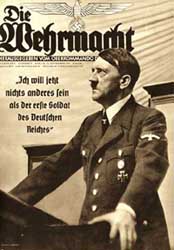 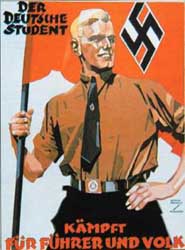 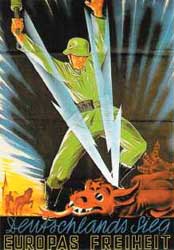
|
"The German student fights for
the Führer and the people" |
"I have no other desire than to
be the first soldier of the German
Reich." |
"Victory for Germany means
freedom for
Europe." | |
The Nazis were
highly effective in their use of propaganda. In
propaganda publications, Hitler was portrayed as
a divine being, while society as a whole was
inspired to war and violence. Above are examples
of Nazi propaganda magazines and newspapers,
printed in various parts of Germany. Nostalgic
and emotionally laden messages are typified on
the propaganda posters below. The public were
incited against an imaginary enemy, and ideas
such as "The German people," and "The German
Army" became false ideals honored by the
public. |
 Propaganda methods were also
employed by Mussolini. Above are some examples
of publications reflecting Italian fascism and
its pagan roots. Below is a slogan employed by
Mussolini which reveals the thinking adopted by
the educational system. It reads, "Believe,
obey, fight," which even primary schoolchildren
were forced to learn by
heart. |
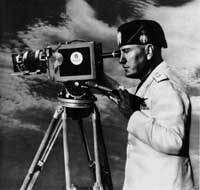
"THE DUCE, THE PERFECT MAN" PROPAGANDA IN
ITALY
Images and publications trying to portray
Mussolini as the perfect man were widespread in
fascist Italy. Images of him with farmers in
their fields, or with children in schools, were
everywhere. The picture above typifies Mussolini
propaganda.
Propaganda posters (left) were also used for
the purpose of inculcating fascist ideals into
society. |
THE USE OF PRESSURE TO ELIMINATE
OPPOSED IDEAS
 Propaganda Minister Joseph
Goebbels (center) |
One interesting example of fascism's efforts to
brainwash society were the book burning ceremonies
in Nazi Germany.
The first of these took place on May 10, 1933.
Students from German universities, which had
previously been recognized as the best in the
world, gathered in Berlin and other German cities,
and burned books which contained "un-German"
ideas. Thousands of books were burned, to the
accompaniment of Nazi salutes, songs and military
music.
In Berlin, Nazi Propaganda Minister Joseph
Goebbels gave a speech to the students stating:

A call in a German youth magazine to
celebrate a book
burning. |
The breakthrough of the German revolution has
again cleared the way on the German path... The
future German man will not just be a man of books,
but a man of character. It is to this end that we
want to educate you. As a young person, to already
have the courage to face the pitiless glare, to
overcome the fear of death, and to regain respect
for death-this is the task of this young
generation. And thus you do well in this midnight
hour to commit to the flames the evil spirit of
the past. This is a strong. great and symbolic
deed-a deed which should document the following
for a world to know-Here the intellectual
foundation of the November (Democratic) Republic
is sinking to the ground, but from this wreckage
the phoenix of a new spirit will triumphantly
rise...37
The fascist state permits only its own ideology
to be taught. Outside of that, nobody must be
allowed to think anything else, or else, he will
be punished, have his books burned, or be silenced
in some other way. Each individual is seen as a
tool at the service of the ideology of the state.
Those who do not agree with the ideology are
intimidated into doing so.
Therefore, the educational system was rendered
to the complete service of the fascist state. The
complete transformation of the educational system
was outlined in the 20th article of the
basic principles of National Socialism. Right from
primary school, children were raised without any
ethical values or human feeling, and in a way
devoid of affection or compassion. They were
educated under the principle that the strong are
most right, and that it is essential to employ
force to achieve one's aims. The organization
created for German children between the ages of
10-18 was known as the Hitlerjugend, or Hitler
Youth. All those who joined the Hitler Youth were
warned that they must be highly vigilant in their
daily lives, and should spy on all those opposed
to the Nazis. Some of them even denounced their
own parents. The Hitler Youth grew steadily, and
by 1935, 60 percent of youth were enrolled in
it.
|
NAZI BOOK
BURNINGS
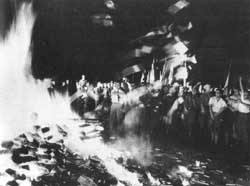 
The fascist state allows
only its own ideology to be read and taught,
being why book burnings are a distinctive
feature of their methods. These scenes are from
a book burning ceremony carried out by German
university students in Berlin on May 10,
1933. |
Another tactic used by all fascist regimes has
been to conceal the true history from society, and
in its place, to teach a fictitious version,
written by themselves. The purpose to this has
been to build a culture in which the fascists'
ideals could thrive, enabling them to become both
more popular and more firmly rooted in society.
The understanding of history, as well as
philosophy, throughout the educational process
were entirely monitored by the fascist state. As
they were educated by the system, people were
entirely unaware that they were being brainwashed
in fascist ideology, and that all other ideas were
completely censored.
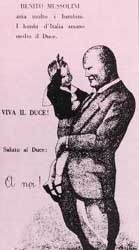 Fascist propaganda was also aimed
at young children. The above poster reads,
"Benito Mussolini loves children. And the
children of Italy love the Duce. Long live the
Duce!" These and similar posters were found in
all schools in Mussolini's
Italy. |
THE IDOLS OF FASCISM: THE SACRED
LEADER

Although fascist propaganda tried
to portray him as divine and infallible, in
actuality, Mussolini was psychologically ill and
unbalanced. His psychological problems could
sometimes be discerned in his
face. |
The most important element of fascism is the
leader, whose name is given prominence in every
aspect of society. The Hitler, Mussolini and
Franco regimes were clear examples of this. The
titles used by these dictators, "Der Führer," "Il
Duce" or "El Caudillo" all signify the same thing-
"The all-knowing leader." And, indeed, the three
ran their respective states totally according to
their own desires, while their closest colleagues
and most senior officers were left out of the
decision-making process.
Fascism ascribes an almost sacred power to the
leader, in order that he can maintain his appeal
and increase his acceptance among the people. The
leader is the ruler of the whole country and of
its people, portrayed as being part of him. A
Nationalist Socialist leader, Herr Spaniol,
speaking at Saarbruecken in January, 1935, said:
I do not believe that the Churches will
continue to exist in their present form. In the
future religion will be called National Socialism.
Its prophet, its pope, its Jesus Christ, will be
called Adolf Hitler.38
In a similar way, Mussolini was seen in Italy
as someone with special abilities, a superior
being, chosen and formed especially for the task
in hand. The commandments and pronouncements
issued by Mussolini were called the "Fascist
Decalogue," and the eighth of these, "The Duce is
always right," became a slogan that was heard all
over Italy in the 1920s and 30s.39
By 1935, membership of the fascist youth
organization, the Opera Nationale Balilla, became
compulsory for all Italian youth. Young Italians
who became a member of Balilla swore to
"...believe in Rome the eternal... in the genius
of Mussolini, in our Holy Father Fascism."40
Another method employed to portray the fascist
leader as sacred was the putting up of his picture
and statues all over the country. This had a
profound psychological effect on the public, who
constantly felt themselves within the leader's
power and under his control, and even, that he was
always watching them.
THE FEELING THAT
"HITLER IS ALWAYS WATCHING YOU"

The reason why posters of the
leader are displayed in all parts of the country
in fascist regimes is to make people feel he is
always watching them. In this manner, a "society
of fear" is maintained. |
Mussolini's official propaganda service used to
advise the press how, when and which of his
pictures was to be printed, on which page, in what
arrangement, and in what size. In these
photographs, "Il Duce" appeared before his people
in pompous poses: brandishing a sword, stressing
economic development in a harvest area, addressing
young fascists, as a tireless worker or
sportsman.
In each case, Mussolini was presented as the
hero of the people. Newspaper pages were adorned
with pictures of him flying planes, jumping
hurdles on horseback, swimming, skiing in the
Alps, fencing, in parachutist costume etc.
So effective was this propaganda that even his
oldest friends used to stand to attention whenever
they saw him. Thus Mussolini was able to satisfy
his enormous ego, not even allowing his oldest
friends to sit down, but keeping them on their
feet for hours.
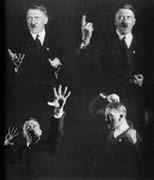 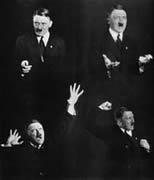 PORTRAITS OF A PSYCHOPATH
According to psychiatrists, Hitler suffered
a number of complexes and was psychologically
unbalanced. But Nazi propaganda portrayed him as
the infallible leader of
Germany. |
The methods employed to portray the fascist
leader as superhuman, during the eras of Hitler
and Mussolini, are also used by modern fascists in
our own time. The fascist dictator in Iraq, Saddam
Hussein, is such an example. For years, the
streets of fascist Iraq have been covered with
huge pictures of him. And, in them, he is shown in
different roles as leader of the people: as a
farmer in the country, a worker in a factory, as a
soldier in the barracks. He makes his presence
felt everywhere, in an attempt to give the
impression of being "one who sees and knows all,"
in other words, a sacred being.
FASCIST ROMANTICISM
A PEOPLE HYPNOTIZED
BY NAZI PROPAGANDA COULD NOT SEE THE
TRUTH

Filled with awe for Hitler, the
German people were capable of ignoring the above
evidence of massacres and
torture. |
However, fascism certainly does not consist
merely of the leader and the fascist party around
him. In both Nazi Germany and Italy, there was
tremendous popular support for the regime. This
was produced in a number of ways. Fascist regimes
are not simply "authoritarian," crushing their
people into silence; they are also
"totalitarian."
The particular feature that attracts people to
a fascist ideology in a totalitarian system is
"extreme romanticism." People who have irrational
and romantic or emotional attachments to ideals
and movements in their own time or in history are
easily led and manipulated, and can even be
provoked to commit crimes. If such people can be
convinced that the cruelties required of them are
carried out for a sacred cause, such as the
"superiority of their own race," there is no limit
to the injustices they can be deluded into
committing. Fascist regimes recognize this, and do
their utmost to keep their people in a state of
irrational emotional exuberance and agitation.
They present what appear to be sacred values to
the people and encourage them in self-sacrifice
for the sake of the state, to despise other
nations or races, and even to torture and
kill.
For this reason, fascist regimes have always
tended to attach great importance to mass rallies,
marches, meetings and ceremonies. Their aim is to
form a sheep-like sense of unity in the people.
The people are first diverted from religion with
symbols, statues, days of remembrance, flags,
torches, and uniforms. Grand moving ceremonies are
designed to replace the experience of religious
ones. These indoctrinated crowds conform to the
fascist ideals, in false joy and excitement, as if
carrying out an act of divine worship. The
frequent repetition of written and shouted
slogans, cries, martial music and salutes are a
vital part of fascist ceremonies.

THE VIOLENCE HIDDEN BEHIND THE
SHOW
Overleaf. Nazi Germany attached great
importance to superficial show. The aim was to
make people oblivious to its cruelty, and cast a
spell over society.
Above. A horrifying look
at a mass grave, proof of Nazi
atrocities. |
These fascist crowds are devoid of any kind of
intelligent thought or behavior. All that remains
is a group of people whipped up by slogans, songs
and poems, but deaf to all reason. These masses,
who identify themselves and their leaders with
heroes from mythology or legends from the past,
carry out their atrocities with an artificially
induced sense of "heroism." If the day comes when
they are called to account for their actions, they
say they did it for the nation, and that they are
actually its heroes. Those who followed Hitler and
Mussolini did so under the effects of such
hypnosis, perpetrating their atrocities in this
state of false excitement.
Under fascism, a person's natural love for his
people and country is turned into a dangerous
sentimentality and a mindless loss of
self-control, whereby whole societies are driven
to kill by exploiting these emotions. (see
Romanticism: A Weapon of Satan, Harun Yahya)
FASCISM'S FALSE SACRED VALUES
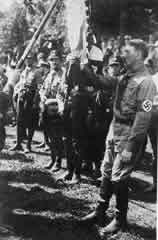 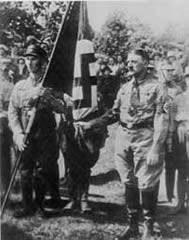
Hitler with a blood flag,
the most sacred symbol in nazi ceremonies.
The blood flag was the most sacred symbol in
Nazi ceremonies. Tens of thousands of other Nazi
Party flags were touched with it, in the belief
that they would be effected by its "sacred"
power. |
Fascism is a faulted creed which sets out to do
away with divine religions and to replace them
with pagan beliefs. And, it is to be expected
that, if false, those values which it holds as
sacred must also be false. For instance, the Nazis
repeatedly used the slogan "Blut and Boden" (Blood
and Soil), and made symbols out of both concepts.
For instance, during Hitler's unsuccessful putsch
in 1923, one of the swastika flags, wet from the
blood of wounded Nazis, was turned into a sacred
relic. Called "Blutfahne," (Blood Flag) it was
conserved just as it was, and was the most sacred
symbol at all Nazi ceremonies. Other, new flags
were touched to it, so that it might transmit
something of its own "sacred" quality.41
War and violence, two more fundamental elements
of fascism, are pagan concepts that it attempts to
portray as sacred values. In divine religions, the
aim is to create a society and world free of
violence and war, whereas under fascism, war is a
virtue by itself. Fascism believes that a people
gain honor and strength from the wars it wages and
from its slain. Naturally, this belief leads to
further wars and the shedding of more blood.
Fascism continually prepares new atrocities and a
river of bloodshed.
THE IMAGINARY ENEMIES OF THE
FASCIST STATE
|
IMAGINARY ENEMIES, IMAGINARY
PLOTS
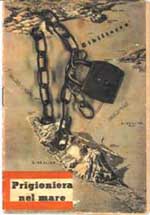
A publication reflecting the
paranoia of Nazi Germany, portraying the French
as an enemy.
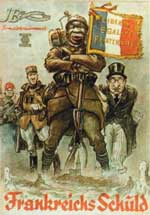
An over-exaggerated message in a
fascist poster, showing Italy chained to the
Mediterranean. |
Fascism is a completely hollow ideology, and
needs to be in a constant state of agitation in
order to survive. The factor that most strengthens
the fascist state in the eyes of its people is the
myth of "internal and external enemies." All
fascist states create imaginary enemies, and
declare all out war on them. The dictatorship
seeks to strengthen by repeated daily media
coverage of glorious victories over the enemy. And
this inspires the belief that, "in order to
protect the people from these great dangers, it is
necessary to be harsh and ruthless to the
opposition." The fascist regime clings to power
with the ever-prevalent idea of "us and them," and
of imaginary enemies of the people. A
justification is thus provided for the erosion of
the force of law, violations of human rights, and
state terrorism. Those who criticize fascism are
automatically accused of cooperating with the
imaginary enemy.
Hitler chose the Jews and communists, Mussolini
the communists, and in our own time, fascists such
as Saddam Hussein the United States, and Slobodan
Milosevic the Muslims, as enemies, and all
creating an artificial unity with this imagined
threat. This fictitious danger is fascism's most
important propaganda weapon, by which a grievous
menace is said to exist, and the fascist leader is
portrayed as a "hero" who will save his people
from it. In this illusory scenario, the artificial
enemy is always brought under attack, and the
fascist leader heroically repels him and defends
his people. That is why the people of Iraq are
still so attached to Saddam Hussein, despite all
his oppression. Saddam has expertly managed to use
his own ruthlessness in the media to denounce
other countries as enemies.
FASCIST PARANOIA
STATE TERROR
AGAINST THE PEOPLE

A characteristic of the fascist
state is its distrust of its own people. Because
fascists know they can only instill obedience
and loyalty by policies of fear and coercion,
they established secret police and intelligence
units targeted against their own populations.
The hundreds of thousands of murders carried out
by the Gestapo are testimony of the extent of
the paranoia of the fascist
state. |
One of the most blatant features of the fascist
state is its distrust of its own people, and the
way by which it attempts to eliminate everybody it
has doubts about through ruthless methods, even to
the extent of murder. Nearly all fascist regimes
institute "secret police" forces to keep their own
populations under control and weed out the
opposition. The infamous Gestapo is a proof of the
scale of the torture and savagery that the
paranoia of fascist regimes leads to. In his book
The True Believer, Eric Hoffer describes the
policy of fear implemented by the Nazis to keep
the public under control.
The ran-and-file within the Nazi party were
made to feel that they were continually under
observation and were kept in a permanent state of
uneasy conscience and fear. Fear of one's
neighbors, one's friends and even one's relatives
seems to be the rule within all mass movements.
Now and then innocent people are deliberately
accused and sacrificed in order to keep suspicion
alive.42
Fascism believes that if people are left to
their own devices they will both betray the regime
and become decadent. The way to bring the people
to heel is by the use of repression. The French
philosopher George Sorel (1847-1922), one of the
ideologues of fascism, and who was a particular
influence on Mussolini, heads the list of those
who believed in the idea. Sorel maintained that
societies naturally became decadent and
disordered. In his view, this decay had to be
prevented by the use of force, through the
establishment of a totalitarian order.
Fascist paranoia still continues today. It is
this suspiciousness that lies behind Saddam
Hussein's having his closest relatives killed on
possibility of "betrayal." After ousting President
Ahmad Hassan al-Bakr in 1979, Saddam had more than
half the Baath Party, of which he was a member,
killed. The criteria for eliminating people were
their intentions, he said, to avoid the harm they
might cause the family in the future. His son Uday
is in charge of the terror machine of liquidating
the "traitors" in the family. Saddam's gang of
assasins-all thugs, psycopaths and killers from
his own clan-became the core of a special security
apparatus that he moulded in 1960's on the Nazi SS
style. It is known that Saddam showed them the
video of the Romanian dictator Nicolai Ceausescu's
fall and execution reminding them that they could
meet an end similar to that of the securitate if
the regime was to fall.43
THE FASCIST LOVE OF VIOLENCE
In a report titled "British in Africa Lack
Killer Urge" published in The New York Times of
June 24, 1942, James Aldridge describes the Nazi
view of war and killing in these words:
The German commanders are scientists, who are
continually experimenting with and improving the
hard, mathematical formula of killing. They are
trained as mathematicians, engineers and chemists
facing complicated problems. There is no art in
it, there is no imagination. War is pure physics
to them. The German soldier is trained with a
psychology of the daredevil track rider. He is a
professional killer, with no distractions. He
believes he is the toughest man on earth.44
|
FASCISM'S
SHOCK TROOPERS
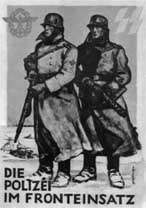
A postcard printed to mark German
Police Day
|
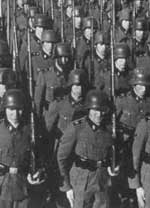
An SS
march-past. |
Not only do fascists motivate
their populations by brainwashing, but also
intimidate by means of terror. Special units are
set up to implement this policy of terror. The
Nazis' SA, SS and Gestapo are typical examples.
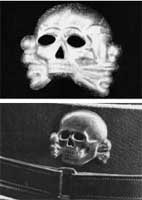 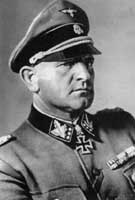
Above. The SS Deaths Head
Division (SS-Totenkopf) was famous for its
ruthlessness. The above version of the
Prussian-style death's head was worn by the SS
until 1934.Left. General Sepp Dietrich, the
commander of the Waffen-SS panzer
corps.
|
This model of "professional
killer" employed by the Nazis is a common feature
of fascism. Fascists regard the use of force and
violence as an end in itself. The influence of
Darwinism plays a major role here. The Darwinist
superstitions that human beings are nothing but
developed animals, and that only the strong can
survive, did away with the ethical values. Love
and compassion were replaced by feelings of
aggression, revenge and struggle, sentiments that
were presented to people as a scientific
necessity.

Mussolini created concentration
camps similar to those of the Nazis. 18,000 of
the 35,000 people Mussolini incarcerated were
killed. |
Fascists see conflict as a law of nature, and
believe that peace, security and comfort impede
the progress of mankind. Mussolini's words, when
opening the Fascist Culture and Propaganda School
in Milan in 1921, are an indication of this, where
he identified action as the force that would lead
fascism to victory.45
Acts of violence, destruction, assaults and
fighting are what keep fascists' morale at a high
level. These are the exact opposite of peace,
brotherhood, peace and tranquility.

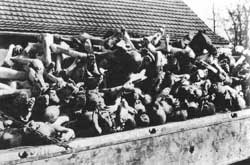
As the allied forces
liberated Nazi-occupied lands, the brutal
genocide the Nazis carried out in the
concentration camps came to light. 11 million
people had been murdered with horrible mass
extermination methods, and those few who were
still alive were half-dead. This form of
barbarity shows the extent of the catastrophes
that Darwinist racism has led
to. |
The ignorance of the fascists also plays a
pivotal role in their tendency towards violence.
That is why Hitler felt the need for fighters in
his racist regime, not intellectuals.
The Nazis' acts of violence were carried to
that end by specially formed organizations. The
first of these, the SA (Sturmabteilung, or Storm
Troopers) were formed in 1920, and in 1921 they
took on a paramilitary quality. There were a great
many street thugs in the ranks of the SA. The
group was also known as the "Brown Shirts," and
was led by Ernst Röhm, known for his psychopathic
nature (and his homosexual tendencies). The SA
carried out countless acts of terrorism throughout
the 1920s in order to strengthen the Nazi Party.
SA units carried out sudden attacks on opponents
of the Nazis, spilt blood in street fights, and
tortured those opponents they took as "prisoners
of war." Hitler took pride in the violence of the
SA. In Mein Kampf, he described one "successful"
attack that was carried out on opponents of the
Nazis:
When I entered the vestibule of the Hofbräuhaus
[beer hall] at a quarter of eight, there could
indeed be no doubt with regard to the existing
intention. The room was overcrowded and had
therefore been closed by the police... The small
S.A. awaited me in the vestibule. I had the doors
to the large hall closed and then ordered the
forty-five or forty-six men to line up... My storm
troopers - for so they were called from this day
on - attacked. Like wolves they flung themselves
in packs of eight or ten again and again on their
enemies, and little by little actually begun to
thrash them out of the hall. After only five
minutes I hardly saw a one of them who was not
covered with blood.46
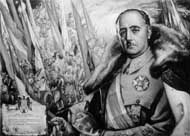
FRANCO AND HITLER'S BRUTAL ALLIANCE
The fascist General Francisco Franco led his
country of Spain into a bloody civil war in
1936, throughout which an average of 500 people
lost their lives every day. By the time it
ended, some 600,000 had died.
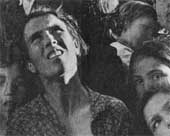 Franco's greatest
supporters were Hitler and Mussolini. Franco's greatest
supporters were Hitler and Mussolini.
In return for Hitler's help, Franco gave to
him the village of Guernica as a gift, where he
tested the giant bombers that had been produced
by Nazi technology. Left. Hitler and Franco
shaking hands. |
The SA began to fall from grace when the Nazis
came to power, and the star of the more
professional SS (Schutzstaffel, or Guard
Detachments), with their military discipline,
began to rise. This corp wore black shirts. Young
people were selected according to "racial
criteria" for membership in the SS. They had to
possess Aryan racial features. The Waffen-SS was
the military wing of the SS. The Totenkopf, or
Deaths Head, Division within the Waffen-SS was
particularly renowned for its cruelty, and was
brought in to man the concentration camps.
Similar camps had also been set up by
Mussolini, and 18,000 of the 35,000 placed in
these "extermination camps" were killed. There
were a great many other deaths, murders, and
unsolved killings throughout the fascist period in
Italy. Mussolini admitted to the cruelty of
fascism in one of his speeches: "Fascism is no
longer liberation but tyranny, no longer the
safeguard of the nation but the defense of private
interests."47
It was also possible to see such examples of
violence in Franco's Spain. Even at the very
outset of the civil war, Franco's ruthless methods
had attracted attention. For instance, in a small
mountain village north of Madrid, 18 people were
arrested for voting for the Popular Front. After
questioning, 13 of these were taken out of the
village by lorry and killed by the side of the
road. When the fascists entered the small town of
Loro del Rio with its population of 11,000 near
Seville, they killed more than 300 people.
Oppression took on a particularly violent form in
the cities. To such an extent that the number of
those killed is even today not known for
certain.48
Franco had hundreds of thousands of his own people
killed, even including the elderly, women and
children. The words of a member of the anti-Franco
resistance in June 1936 describes the situation:
Thousands of people have been tortured, women
who refused to turn in their loved ones have been
hung upside down, children have been shot, and the
mothers who witnessed the torture of their
children have gone mad…49
Franco dragged Spain into a terrible civil war.
Brother fought against brother, and father against
son. An average of 500 people died every day. Acts
of violence, slaughter, mass torture, and killings
went on without end. The Spanish Civil War left
some 600,000 dead in its wake.
Hitler and Mussolini used Spain as a
laboratory, a testing-ground for new troops and
weapons.50
The most terrible example of this was a village
that Franco presented to Hitler as a gift in
return for his assistance. On the morning of May
5, 1937, the people of the village of Guernica
were wiped out by the huge bomber planes
manufactured by Nazi technology. Franco had left
the little village as an experiment for Nazi
planes.51
FASCISM'S POLICY OF CONQUEST

Nazi General Erwin Rommel during
the occupation of northern Africa in
1942. |
Another feature without which fascism cannot
survive is its policy of expansion by conquering
other countries. The basis of this policy of
conquest is racism, and the concept of "the
struggle for survival between the races," a legacy
of Darwinism. Fascist states believe that in order
to develop as a nation, they have to conquer
weaker nations, and grow by absorbing them.
According to fascist thinking, man can only
progress by engaging in war. Therefore,
"militarism" is fascism's most defining
characteristic. In order to encourage this martial
spirit, fascist parties attempt to impress their
citizens with their uniforms and pompous
ceremonies. In Mussolini's words, "Fascism...
believes neither in the possibility nor the
utility of perpetual peace. War alone brings up to
its highest tension all human energy and puts the
stamp of nobility upon the peoples who have
courage to meet it."52
Mussolini expressed his opposition to peace in
another speech, saying, "I do not believe in
peace, but I find it depressing and a negation of
all human virtues of man."53
Mussolini inflicted great suffering, both on
his own people and on those in the countries he
occupied, in the name of his ideology. He occupied
Ethiopia(Abyssinia) in 1935, and 15,000 innocent
Muslims were killed towards his dreams of
"reviving the Roman Empire." He had no compunction
about ordering civilians who tried to fight the
occupation to be shot. He was also responsible for
terrible atrocities through the use of poison gas
against civilians.
The most grievous example of fascism's politics
of occupation is, of course, Nazi Germany. The
Nazis claimed that the Germans, "the master race,"
needed "room to live" beyond the frontiers of
Germany, and for that reason sparked World War II.
Within a very short time, the German Army had
occupied Poland, Belgium, the Baltic countries,
France, the Balkan peninsula and Northern Africa,
invaded Russia as far as Moscow, and headed from
there to the Caspian Sea. This murder, which
ultimately culminated in a disaster for the German
people as well as for those of other countries,
left 55 million dead, and was the bloodiest legacy
of fascism in the 20th century.
|
FASCIST ITALY'S
OCCUPATION OF ETHIOPIA
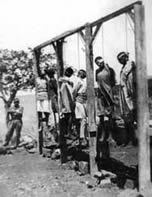 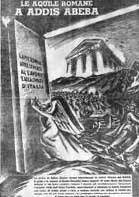 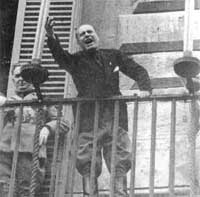
Mussolini
occupied Ethiopia in 1935 with dreams of
"restoring the Roman Empire." 15,000 innocent
Muslims were killed by the Italians. Mussolini
gave the order that any civilian who opposed the
occupation should be shot, and carried out
massacres with the use of poison
gas.
Left. Six
Muslim Ethiopian resistance fighters hanged by
the Italian forces of occupation.
Fascist
propaganda: The Italian occupation was portrayed
as bringing the "advanced" civilization of Rome
to
Ethiopia. |
|
 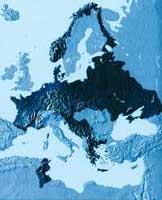
Nazi Germany is the worst
example of fascism's policy of occupation. The
map shows those countries under Nazi occupation
at the end of 1942.
|
THE FASCIST SYSTEM'S ATTACK ON
ART

Statue by Ferruccio Vecchi: "The
Empire Emerging from the Duce's
Head." |
Another disturbing aspect of fascism is that
people living under such a regime are unable to
develop their artistic talents, and that their
scientific research fails to produce any
productive results.
FASCISM'S ERRANT
INTERPRETATION OF ART 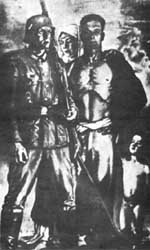
Fascist ideology removes any
aesthetic value from art and turns it instead
into a propaganda tool, as in this picture
called "Friendship" by the Nazi artist Helmut
Ullrich. The themes in this picture are "The
heroic German warrior" and "A child representing
the Aryan race." |
In order to determine the reason for this, we
must first define what art is. Art is found in
people taking pleasure in beauty and wanting to
express it. Therefore, it first of all requires a
soul capable of appreciating beauty. For instance,
an artist who possesses feelings such as love and
affection can see beauty in an animal, a
landscape, or a plant. He experiences a feeling of
joy, which he then tries to depict. A composer, in
the presence of such beauty produces beautiful
music, because his soul, feeling that beauty,
longs to express it. The same applies to every
other type of art, from literature to music.
However, it is impossible for those with a dark
and cold soul, who are used to oppression and
cruelty, and who have lost all semblance of
humanity, to produce art. It is impossible for a
person who believes in aggression and the
superiority of force, who considers that bloodshed
is necessary, who sees the world as a
battleground, a kind of arena where only the
strong have the right to live, to be affected by
the beauties of nature or human beings, and
influenced by their intricacies.
Those are the characteristics of fascists, and
therefore, it is impossible for a fascist to
possess any artistic feeling. The fascist soul is
utterly debilitated and ignorant, and lacks all
understanding, and considers art
"unnecessary."
Actually, the fascists' hostility to art goes
back to ancient Sparta, that ancient city which
they took as a model. At a period when art was
greatly prized in Athens, Sparta saw art as
unnecessary, and raised its citizens instead to
become warriors from an early age. It was
virtually forbidden for Spartan children to take
an interest in subjects such as reading and
writing or art in their education.

A publicity poster for an
exhibition held by the Nazi administration in
1938. The aim of the exhibition was to display
and denigrate works that did not conform to Nazi
cultural policies. |
In 20th century fascist states,
works of art, if any, were prepared and controlled
by the state to serve as propaganda. These were
the products of a soulless and mechanical "art to
order." No real works of art emerged. For
instance, only those subjects that the state
allowed could be painted, such as war. Subjects
disliked by the state were forbidden. The same
applied to the written word, only those things the
fascist state permitted could be written about,
and nothing else. As a result, art totally
unrelated to true art emerged, that,
aesthetically, rendered art, architecture and
literature rigid, soulless and dull.

IN FASCISM, "ART EQUALS WAR"
The artistic themes most frequently employed
in Nazi Germany were "heroism" and "war." This
is evident in Franz Eichhorst's The Warrior in
Poland. |
The most obvious examples of this were seen in
Hitler's Germany. Because of his racist views,
Hitler boycotted certain art forms. For example,
because he looked on Africans as an "inferior
race," the playing of jazz was forbidden in
Germany, for it was regarded as "black man's
music." In 1935, Eugen Hadamowski, the head of
German radio, announced that by order of Hitler,
he prohibited the playing of Negro jazz on German
radio.
At the beginning of the 1940s, at the height of
Hitler's power, jazz began to be used as a
propaganda tool in radio broadcasts directed at
Great Britain and America. At that time, and in
most countries, jazz was one of the most popular
forms of music. Europe's greatest jazz musicians
were brought together. The first thing done was to
translate all the English names of the famous jazz
songs into German. The lyrics of these songs were
altered to conform with Nazi propaganda, and was
played only on programs aimed at the West, and
completely forbidden on domestic German
radio.
The lyrics of the songs were entirely fascist
in content. Here is one example.

A 1940 wall painting by Massimo
Campigli, one of the Italian artists employed by
the fascist administration, at the entrance to
Padua University. |
You're the greatest… You're a German pilot…
You're machine gun fire… You're a heroic
submariner… You're the greatest… You're a German
bomber…54
That was the Nazis' idea of art and music.
Paintings, song lyrics, music and literature were
all expected to include subjects approved of by
the state. Painters could only paint subjects that
encouraged the spirit of war.
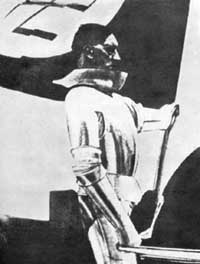
Another intention of fascist art
is to portray the leader as sacred. This was the
aim in Hubert Lanzinger's portrait of Hitler The
Flag-Bearer. |
For instance, when the above-mentioned "state
controlled jazz group" produced a record that did
not consist of Nazi propaganda, they were
immediately accused of being "degenerate" and
warned never to try such a thing again.
And, that was not the end of Hitler's measures
against artists. After the race laws of 1933, the
Reichsmusikkammer (Reich Music Chamber) required a
registry of all German musicians.
As a result, hundreds of talented composers had
their work deliberately suppressed and careers
ended simply because their race or style of music
offended the Third Reich. Famous works by
Mendelssohn, Mahler and Schoenberg were used as
examples of unacceptable music.55
According to Hitler, the role of art was to
carry political messages in order to shape the
mind of the public. What to Hitler was true art
was that which portrayed life in the countryside,
the healthy, and the Aryan race. In one speech, he
offered his views on art and artists:
We shall discover and
encourage the artists who are able to impress upon
the State of the German people the cultural stamp
of the Germanic race... in their origin and in the
picture which they present they are the
expressions of the soul and the ideals of the
community.56
As can be discerned from all that has been
mentioned, the artistic talents and scientific
endeavor of people living under fascist regimes
are ultimately fruitless. On the other hand,
however, a society which lives by true religion
sees great progress and development in the arts.
Since religious people know that the universe and
all living things in it were created by God, they
look at everything around them with the intention
of recognizing their beauty. They see the art in
God's creation and are in awe of it. They see
people, animals, plants and everything in nature
as God's creations, and both love and appreciate
them, realizing their beauty and detail. In fact,
the greatest works of art in history arose out of
inspiration artists have found in religious
subjects.
FASCISM'S HATRED OF WOMEN
There is another little known but exceedingly
important aspect of fascism. It has an inimical
attitude towards women, and sees them as inferior
to men.
This fact is recognizable in words and
statements of 20th century fascist
leaders. For instance, Mussolini's statement to
Maurice de Valeffe, a reporter for the French
publication Journal, on Nov. 12, 1922, openly
belittled women:
There are those who say that I intend to limit
the right to vote. No! Every citizen will keep his
right to vote for the Rome Parliament… Let me also
admit to you that I am not thinking of extending
the vote to women. There would be no point. My
blood opposes all kinds of feminism when it comes
to women participating in state affairs. Naturally
a woman shouldn't be a slave, but if I conceded
her the vote, I'd be laughed at. In our state, she
must not count.57
During the serious economic crisis beginning in
1930, Mussolini ordered that women should leave
their places of work. Because he saw women as
"thieves who reach out to steal men's bread, and
responsible for men's unproductiveness."58
The Duce's views on women are strikingly
apparent in an interview he granted the French
journalist Hélène Gosset in 1932:

Fascism is mired by a hatred of
woman, whom it regards as
inferior. |
Women must submit… Even if they have an
analytical power, they have no synthetic one. Have
they ever put up an architectural structure? I am
not talking about a temple: a woman could do no
better than erecting a hut. Women are strangers to
architecture, the synthesis of all the arts: and
their destiny ends at this point.59
Through various measures, restrictions on women
in the workplace were also imposed in education.
For instance, a decree of Jan. 30, 1927 forbade
women in high school from taking classes in
literature and philosophy. A decree passed in 1928
resorted to legal measures to oppose women's
education, and women were prevented from becoming
directors of middle schools. Female students were
required to pay double the fees in schools and
universities.
A decree which Mussolini put before Parliament
on Nov. 28, 1933 declared, "State bodies are
empowered to impose conditions excluding women in
advertisements for exams to take on new
employees.. They must impose limits against a rise
in the number of female workers in public
offices…"60
According to a decree instituted by force of law
on Sept. 1, 1938, women could only make up 10
percent of the workforce in public offices.
In Nazi Germany the status of women as "second
class citizens" was even more pronounced. The
German Education Ministry decided that women
should make up no more than 10 percent of high
school graduates. In 1934, only 1,500 out of every
10,000 female high school graduates were allowed
to proceed to higher education. In 1929, there
were 39 National Socialist education bodies. Only
two of these were for women. Laws were passed
banning women from taking Latin classes in middle
school: before having even finished high school,
they were prevented from going on to university.61
These decrees did not just represent a social
ideology or merely imposed regulations to foster a
division of labor, they were actually the
implementation of the biological dogma of Nazism.
Maria A. Macciocchi, author of Eléments pour une
Analyse du Fascisme comments that in the eyes of
the Nazis, women were a kind of animal.62
According to such a philosophy, women were a
primitive race, at a lower level in biological
terms.63
THE DARWINIST ROOTS OF THE
HOSTILITY TO WOMEN
The root of this prejudice among fascists
towards women was, as in so many other matters,
Darwinism. Fascists did not merely appropriate the
idea of the inequality between the races from
Darwinism, they also adopted the idea that men
were superior to women.
In The Descent of Man, Darwin wrote that women
some of whose "powers of intuition, of rapid
perception, and perhaps of imitation are
characteristic of the lower races, and therefore
of a past and lower state of civilisation."64
According to Darwin, evolution meant "a struggle
of individuals of one sex, generally males, for
the possession of the other sex."65
In the Descent, Darwin also wrote, "Man is more
powerful in body and mind than woman, and in the
savage state he keeps her in a far more abject
state of bondage than does the male of any other
animal; therefore it is not surprising that he
should have gained the power of selection."66
Evolution was in the hands of men, and women were
basically passive. As a result, women had evolved
less and were more primitive, for which reason
women were dominated by instinct and emotions,
which was their "greatest weakness."67
Darwin maintained his views on the superiority
of men and its importance for evolution throughout
his life. He had this to say about this issue also
by referring to his cousin Francis Galton's
theories:
The chief distinction in the intellectual
powers of the two sexes is shewn by man's
attaining to a higher eminence, in whatever he
takes up, than can woman-whether requiring deep
thought, reason, or imagination, or merely the use
of the senses and hands. If two lists were made of
the most eminent men and women in poetry,
painting, sculpture, music (inclusive both of
composition and performance), history, science,
and philosophy, with half-a-dozen names under each
subject, the two lists would not bear comparison.
We may also infer, from the law of the deviation
from averages, so well illustrated by Mr. Galton,
in his work on Hereditary Genius, that if men are
capable of a decided pre-eminence over women in
many subjects, the average of mental power in man
must be above that of woman.68
Darwin's views could also be recognized in his
personal outlook towards women. He described a
woman's role in marriage as "constant companion,
(friend in old age) who will feel interested in
one, object to be beloved and played with-better
than a dog anyhow-Home, and someone to take care
of house ..."69
It is evident that Darwin looked at women and the
institution of the family from a materialistic
standpoint. There was not a trace of love,
respect, loyalty, affection or compassion in his
outlook.
The evolutionist and materialist Carl Vogt, a
contemporary of Darwin and a Geneva scholar of the
mid nineteenth century, also held disparaging
views regarding women. "We may be sure that
wherever we perceive an approach to the animal
type the female is nearer to it than the male" he
wrote. "Hence we should discover a greater
[apelike] resemblance if we were to take a female
as our standard."70
Many evolutionists, following Darwin, have
continued to maintain that women are inferior to
men, both biologically and intellectually. Some
evolutionists have even classified men and women
as two distinct psychological species: males were
homo frontalis, females homo parietalis.71
One evolutionist, Elaine Morgan, noted that Darwin
had motivated men into researching the reasons why
women were "manifestly inferior and irreversibly
subordinant".72
Paul Broca (1824-1880), an evolutionist
physicist and anthropologist, was particularly
interested in the differences in intelligence and
brain size between men and women, ascribing their
inferior intelligence to the smaller size of their
brains.
Another follower of Darwin, the evolutionist
social psychologist Gustave Le Bon, wrote;
In the most intelligent races ... are a large
number of women whose brains are closer in size to
those of gorillas than to the most developed male
brains. This inferiority is so obvious that no one
can contest it for a moment; only its degree is
worth discussion. ... Women ... represent the most
inferior forms of human evolution and ... are
closer to children and savages than to an adult,
civilized man. They excel in fickleness,
inconsistency, absence of thought and logic, and
incapacity to reason. Without a doubt there exist
some distinguished women ... but they are as
exceptional as the birth of any monstrosity, as,
for example, of a gorilla with two heads;
consequently, we may neglect them entirely.73
Therefore, at the basis of fascism's
disparagement of and contempt for women lies the
theory of Darwinism. Mussolini's taking away of
women's social rights, and Hitler's building of
"breeding farms" to reproduce the superior race
and obliging young girls to sleep with SS
officers, are all reflections of fascists'
attitudes to women. Both Darwinists and fascists
are enemies of women. They see them as an inferior
and backward species, and both despise them, as
well as employing discriminatory and oppressive
methods against them.
This fascist perspective is completely at odds
with the ethics of the Koran. God has commanded in
the Koran that women should be cherished,
respected, and protected. In addition, He has
shown examples of women with superior morals, such
as Mary and the wife of Pharaoh. In the eyes of
God, superiority does not lie in race, sex or
rank, but in closeness to Him and strength of
belief. In a number of verses of the Koran, God
has revealed that all believers will receive their
reward without discrimination between men and
women.
Their Lord responds to
them: "I will not let the deeds of any doer among
you go to waste, male or female-you are both the
same in that respect…" (Koran, 3:195)
Anyone, male or female, who
does right actions and is a believer, will enter
the Garden. They will not be wronged by so much as
the tiniest speck. (Koran, 4:124)
Anyone who acts rightly,
male or female, being a believer, We will give
them a good life and We will recompense them
according to the best of what they did. (Koran,
16:97)
However, as religion was abandoned, these
truths were abandoned with it, and in their place
were provided superstitions such as fascism and
Darwinism, in which all forms of discrimination
based on sex or race are seen as justified.
FASCISM'S SEXUAL DEVIATIONS
The hostility to women that we have so far
examined is actually the manifestation of a dark
subconscious tendency. Fascism equated feelings
such as love, compassion and affection with
womanhood, and thus regarded it as despicable. On
the other hand, tendencies such as the love of
war, bloodlust and ruthlessness were seen as
typically "male," and for that reason "manliness"
was elevated to the point of being sacred.

The Nazis' tendencies towards
homosexuality were inspired by the prevalence of
it in ancient pagan societies, especially in
ancient Greece. This statue by Josef Thorak,
called Kameradschaft (Friendship), reflects the
Nazis' idea of
sexuality. |
When fascism's myth of "manliness" is examined
a bit closer, however, there we find homosexuality
hidden within it. This little known but important
connection between fascism and homosexuality dates
back as far as ancient Sparta.
In earlier chapters of this book, we saw that
fascism was founded on pagan culture, and that it
emerged together with claim of re-awakening
paganism. The most defining characteristic of
paganism is that it lacks the moral criteria and
laws revealed by God. In the pagan world,
therefore, sexual deviance of all kinds was able
to flourish. It was the city-states of ancient
Greece that brought these to their highest point.
In Athens and Sparta, homosexuality was seen as
quite normal, an acceptable relationship, and even
a virtue.
In Sparta especially, the ancestor of fascism,
a special importance was attributed to the concept
of "manliness," and under the name of "love of
man," homosexuality was widely accepted. Spartan
soldiers believed that they increased their
strength by having sexual relations with each
other. The historian Plutarch of Chaeronea, who
lived around 50-120 A.D., wrote of "the sacred
battalion" of Thebans made up of 150 male
homosexual pairs.74
In Sparta, all healthy male children were taken
into the army at the age of 12, and were
immediately raped by experienced soldiers. It was
believed that these perverted relations were the
greatest source of strength for the Spartan army,
with its "warrior" culture and passion for
bloodshed.
Such a debased and deviant culture raised its
head again with the neo-pagan movement of the
19th century. And, the major center of
this deviancy was Germany. The leader of the
movement, Adolf Brand, founded the Gemeinschaft
der Eigenen (Community of the Elite) in 1902,
together with Wilheml Jansen and Benedict
Friedlander, both of whom were known for their
deviant sexual tendencies. Friedlander published a
book called Renaissance des Eros Uranios
(Renaissance of Uranian Erotica) in 1904. On the
cover was a picture of a naked Greek youth.
Friedlander explained the aim of the book in these
words:

According to the documents cited
in The Pink Swastika, homosexual tendencies
among Nazis were very widespread.
|
The positive goal...is the revival of Hellenic
chivalry and its recognition by society. By
chivalric love we mean in particular close
friendships between youths and even more
particularly the bonds between men of unequal
ages.75
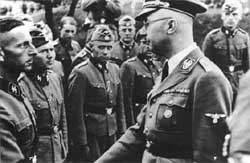
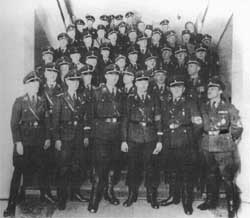
There were so many
homosexuals in the Nazi movement that the Nazi
Party has been compared to a "homosexual club."
Above: SS Chief Heinrich Himmler with his
officers. |
The aim of the community was to transform
Germany from a Judeo-Christian society to a
Greco-Uranian one.76
This deviant organization was also known for its
racism. Referring to the ideas of the Community of
the Elite, Kurt Hildebrandt, the leader of the
Society for Human Rights established in 1923,
wrote in his book Norm Entartung Verfall (Ideal,
Degeneration, Ruin) that the superior race was
that composed of homosexuals. In his view,
relations with women were only necessary for
"reproductive reasons," but that in order to
achieve an "ultramasculine" race, sexual "love"
between men was essential.
These ideas were none other than those of the
Nazi Party, which was basically a "homosexual
club."
This fact was set out by Scott Lively and Kevin
Abrams in their book The Pink Swastika:
Homosexuality in the Nazi Party, a wide-ranging
study. The book examines both pre-Nazi movements
and organizations, as well as the Nazi Party
leadership, and reveals that there was a large
number of homosexuals within it. It explains, with
historical documentation, how the Nazis' policy of
rounding up homosexuals and sending them to
concentration camps was all for show, and that by
doing so, senior Nazi leaders were trying to cover
up their own practices. Among the known Nazi
homosexuals were SA chief Ernst Röhm, Gestapo
chief Reinhard Heydrich, Luftwaffe chief Herman
Goering, Rudolf Hess, leader of the Hitlerjugend
(Hitler Youth) organization Baldur von Schirach,
Nazi Germany's Finance Minister Walther Funk, and
Hitler's land Forces commander Freiherr Werner von
Fritsch. There is also evidence to suggest that SS
chief Himmler and Hitler himself also had
homosexual tendencies.77
The Pink Swastika also demonstrates that this
tendency was not restricted to Nazis in Germany,
and that there are many homosexuals in neo-Nazi
movements and racist organizations active in the
United States, and shows that such deviance is a
regular feature of fascism. Fascist pagans indulge
in the sin as related in the Koran, that of the
people to whom the prophet Lot was sent.
However, those who engage in these practices
must not forget what happened to the people of
Lot. The disaster visited on them is described in
the Koran in this way:
And Lot, when he said to
his people, "Do you commit an obscenity not
perpetrated before you by anyone in all the
worlds? You come with lust to men instead of
women. You are indeed a depraved people." The only
answer of his people was to say, "Expel them from
your city! They are people who keep themselves
pure!" So We rescued him and his family-except for
his wife. She was one of those who stayed behind.
We rained down a rain upon them. See the final
fate of the evildoers! (Koran, 7:80-84) |